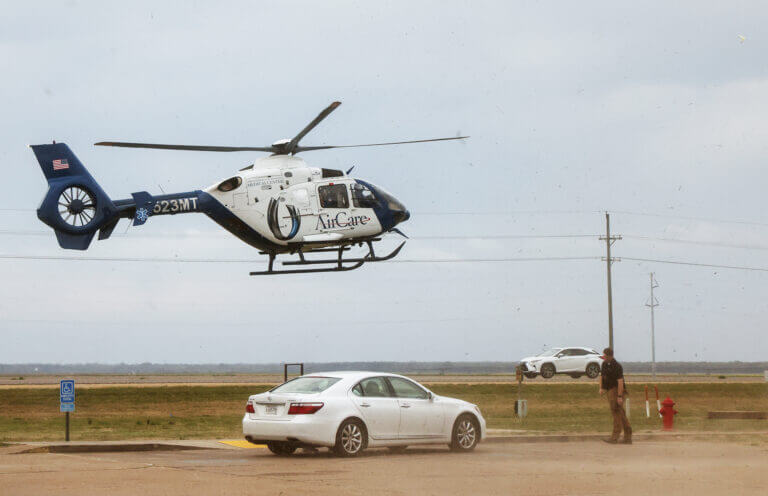

The National Transportation Safety Board released a preliminary report last week in its investigation of the UMMC helicopter crash in March that killed three crew members.
AirCare 3 – one of four helicopters in UMMC’s critical care transport program – was destroyed March 10 after it crashed on a grass field in Canton.
The pilot and two UMMC employees died in the crash: Cal Wesolowski of Starkville; Dustin Pope, a flight nurse and the base supervisor for AirCare in Columbus; and Jakob Kindt, a critical care paramedic from Tupelo. Denton, Texas-based Med-Trans Corporation provides helicopters and pilots to UMMC.
The preliminary report does not identify the cause of the crash, and the final report could take one to two years to be completed, National Transportation Safety Board member Todd Inman told press after the crash.
The flight was headed to its home base at Golden Triangle Regional Airport in Columbus after the crew completed a patient transport to St. Dominic Hospital in Jackson and topped off its fuel at the University of Mississippi Medical Center, according to the report.
The flight was classified as low-risk by the operator’s safety management system.
The helicopter communicated with air traffic control at Jackson-Medgar Wiley Evers International Airport and terminated communication about five minutes before the accident, after the pilot reported “clear to the north.”
The helicopter flew over the Ross Barnett Reservoir northeast of Jackson and reached an altitude of 2,500 feet above mean sea level before it began to descend north of the reservoir.
The flight nurse transmitted a message to the UMMC’s aircraft communications center about halfway through the descent. “We’ve got a major problem, we are having an emergency landing in a field right now, ops are not good, controls are giving us a lot of trouble, coming in fast,” he said.
No further radio transmissions were recorded from the helicopter.
The helicopter impacted multiple trees south of a flat grass field in the Pearl River State Wildlife Management Area before coming to rest in the field.
A manager at Turcotte Fish Hatchery 700 yards from the accident site heard a “boom” or “explosion” while the helicopter was still airborne. He did not hear engine sounds after the boom and did not see smoke or fire coming from the helicopter while it remained airborne, he told the National Transportation Safety Board in a postaccident interview.
It appeared the pilot was “having trouble controlling” the helicopter, and that the tail was pitching up and down, he said. The craft did not descend straight down but was “coasting,” in a 40 to 45 degree angle descent.
The time from “boom” to impact with the ground was about 15 seconds, he reported.
The helicopter was destroyed by a post-impact fire that burned for three hours. Fire department units deployed 1,300 feet of hose after the initial fire suppression, which was carried out using tank water. Water was then shuttled to the site for the remainder of firefighting.
The National Transportation Safety Board, Federal Aviation Administration, Med-Trans Corporation and Colorado-based Global Medical Response, the company that owns Med-Trans, traveled to the site of the crash but were unable to functionally test any of the helicopter systems due to the fire damage.
Wesolowski, the pilot, was hired by Med-Trans in September 2024 and passed a competency checkride in October. He had completed over 10,000 hours as a helicopter pilot, according to the report.
The helicopter, a Eurocopter EC135 P2+, was inspected two and a half hours before the accident. It was manufactured in 2012 and transferred to the Med-Trans operating certificate in 2020.
There have been 12 other crashes involving the Eurocopter EC135 since 2005, according to publicly available information from the National Transportation Safety Board.
The Federal Aviation Administration issued an airworthiness directive pertaining to the helicopter model three days before the crash, to take effect March 24, 2025. Airworthiness directives are legally enforceable regulations to correct an unsafe condition in a product.
The directive was “prompted by reports of malfunctioning emergency fuel shut-off switches on the warning unit,” and mandated inspections of certain switches on the warning units and depending on the result of the inspections, replacing or repairing the warning unit.
AirCare flights were temporarily grounded after the crash but have now resumed operations.
The post Preliminary report released in UMMC helicopter crash appeared first on Mississippi Today.
- IHL taps members for Jackson State president search advisory group - November 24, 2025
- DNA evidence tied to rape, killing of 6-year-old Greenville girl is missing, attorneys allege in court filing - November 24, 2025
- Egg Bowl week begins as Kiffin’s run at Ole Miss appears to be at end - November 24, 2025